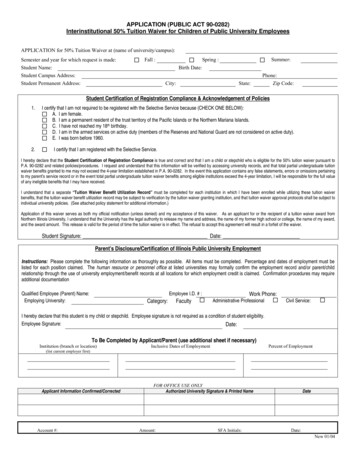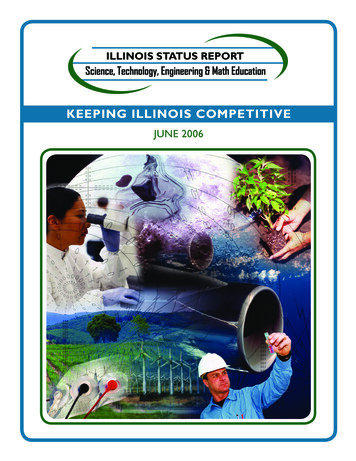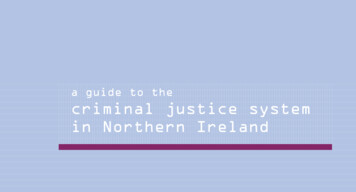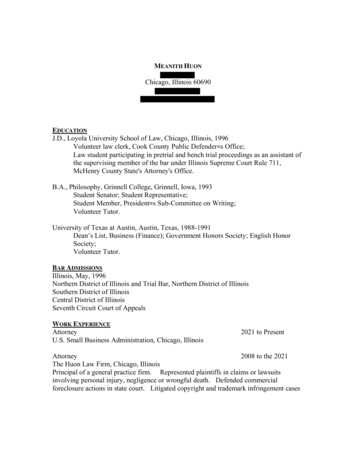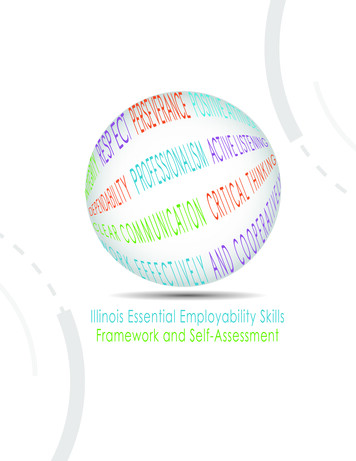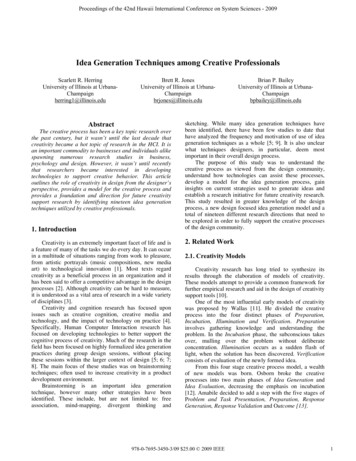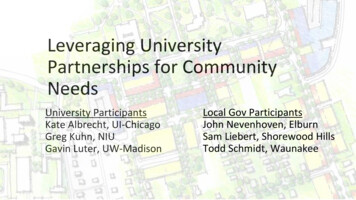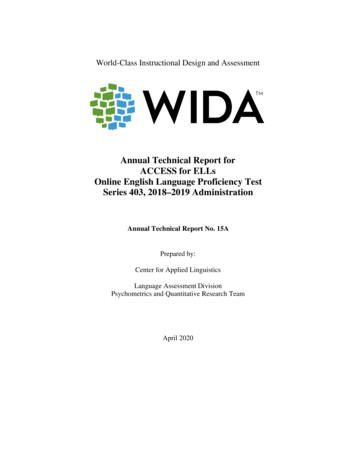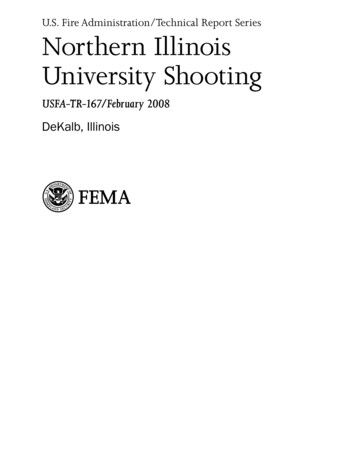
Transcription
U.S. Fire Administration/Technical Report SeriesNorthern IllinoisUniversity ShootingUSFA-TR-167/February 2008DeKalb, Illinois
Department of Homeland SecurityU.S. Fire AdministrationMajor Fire Investigation ProgramThe United States Fire Administration (USFA) develops reports on selected major fires throughout the country. The fires usually involve multiple deaths or a large loss of property. But theprimary criterion for deciding to write a report is whether it will result in significant “lessonslearned.” In some cases these lessons bring to light new knowledge about fire—the effect of buildingconstruction or contents, human behavior in fire, etc. In other cases, the lessons are not new, but areserious enough to highlight once again because of another fire tragedy. Sometimes, special reportsare developed to discuss events, drills, or new technologies or tactics that are of interest to the fireservice.The reports are sent to fire magazines and are distributed at national and regional fire meetings. Thereports are available on request from USFA. Announcements of their availability are published widelyin fire journals and newsletters.This body of work provides detailed information on the nature of the fire problem for policymakerswho must decide on allocations of resources between fire and other pressing problems, and withinthe fire service to improve codes and code enforcement, training, public fire education, buildingtechnology, and other related areas.The Fire Administration, which has no regulatory authority, sends an experienced fire investigatorinto a community after a major incident only after having conferred with the local fire authorities toensure that USFA’s assistance and presence would be supportive and would in no way interfere withany review of the incident they are themselves conducting. The intent is not to arrive during the eventor even immediately after, but rather after the dust settles, so that a complete and objective review ofall the important aspects of the incident can be made. Local authorities review USFA’s report whileit is in draft form. The USFA investigator or team is available to local authorities should they wish torequest technical assistance for their own investigation.
Northern Illinois University ShootingDeKalb, IllinoisFebruary 14, 2008Reported by: Hollis StambaughThis is Report 167 of Investigation and Analysis of Major Fire Incidents and USFA’s Technical Report Series Project conducted byTriData, a Division of System Planning Corporation, under Contract(GS-10-F0350M/HSFEEM-05-A-0363) to the DHS/United States FireAdministration, and is available from the USFA Web page at http://www.usfa.dhs.govDepartment of Homeland SecurityUnited States Fire AdministrationNational Fire Data Center
U.S. Fire AdministrationMission StatementWe provide National leadership to foster a solid foundationfor local fire and emergency services for prevention,preparedness and response.
ACKNOWLEDGMENTSThe research for this report was greatly facilitated by the generous cooperation and support of thefollowing individuals:Bruce HarrisonFire Chief, City of DeKalb Fire DepartmentLanny RussellRetired Fire Chief, City of DeKalb Fire DepartmentTraci LeMayAdministrative Assistant, City of DeKalb Fire DepartmentMelanie MagaraAssistant Vice President for Public Affairs, Northern Illinois UniversityDennis MillerDeKalb County Coroner and Emergency Management CoordinatorThe USFA and the author of this report also would like to extend our gratitude to Northern IllinoisUniversity (NIU) President, Dr. John Peters, and to Virginia Polytechnic and State University (VirginiaTech) in Blacksburg, Virginia. The information that Virginia Tech shared with NIU and others concerning the tragedy at the Virginia Tech campus has significantly contributed to improved campusemergency preparedness at schools across the country, including at NIU. We also honor the victimsof the February 14, 2008, assault and extend our sincerest wishes for the continued healing of thefamilies and the campus community.Remembering the victims of February 14, 2008.
TABLE OF CONTENTSCHAPTER 1: FIRE, RESCUE, SECURITY, AND EMERGENCY PREPAREDNESS AT NORTHERNILLINOIS UNIVERSITY . . . . . . . . . . . . . . . . . . . . . . . . . . . . . . . . . . . . . . . . . . . . . . . . . . . . . 1Fire and Rescue. . . . . . . . . . . . . . . . . . . . . . . . . . . . . . . . . . . . . . . . . . . . . . . . . . . . . . . . . . 1Automatic Aid and Mutual Aid . . . . . . . . . . . . . . . . . . . . . . . . . . . . . . . . . . . . . . . . . . . . . . 2Campus Security and Crime Statistics . . . . . . . . . . . . . . . . . . . . . . . . . . . . . . . . . . . . . . . . . 3Emergency Preparedness. . . . . . . . . . . . . . . . . . . . . . . . . . . . . . . . . . . . . . . . . . . . . . . . . . . 4State of Illinois. . . . . . . . . . . . . . . . . . . . . . . . . . . . . . . . . . . . . . . . . . . . . . . . . . . . . . . . . . 5CHAPTER 2: BRIEF HISTORY OF THE NORTHERN ILLINOIS UNIVERSITY SHOOTER ANDPARALLELS TO THE VIRGINIA TECH SHOOTER . . . . . . . . . . . . . . . . . . . . . . . . . . . . . . . . . . 7CHAPTER 3: THE INCIDENT AND MULTIAGENCY RESPONSE WITH TIMELINE . . . . . . . . . . 11First Actions . . . . . . . . . . . . . . . . . . . . . . . . . . . . . . . . . . . . . . . . . . . . . . . . . . . . . . . . . . . 11Triage and Treatment. . . . . . . . . . . . . . . . . . . . . . . . . . . . . . . . . . . . . . . . . . . . . . . . . . . . . 13Staging. . . . . . . . . . . . . . . . . . . . . . . . . . . . . . . . . . . . . . . . . . . . . . . . . . . . . . . . . . . . . . . 17Timeline. . . . . . . . . . . . . . . . . . . . . . . . . . . . . . . . . . . . . . . . . . . . . . . . . . . . . . . . . . . . . . 22Additional Resources . . . . . . . . . . . . . . . . . . . . . . . . . . . . . . . . . . . . . . . . . . . . . . . . . . . . 23Campus Alert and Public Information. . . . . . . . . . . . . . . . . . . . . . . . . . . . . . . . . . . . . . . . 24CHAPTER 4: HOSPITAL AND CORONER’S OFFICE RESPONSE. . . . . . . . . . . . . . . . . . . . . . . . . 28Arriving Families and Information. . . . . . . . . . . . . . . . . . . . . . . . . . . . . . . . . . . . . . . . . . 31Second Wave of Patients . . . . . . . . . . . . . . . . . . . . . . . . . . . . . . . . . . . . . . . . . . . . . . . . . . 32CHAPTER 5: AFTERMATH AND HEALING THE WOUNDS . . . . . . . . . . . . . . . . . . . . . . . . . . . . 33CHAPTER 6: FINDINGS AND LESSONS. . . . . . . . . . . . . . . . . . . . . . . . . . . . . . . . . . . . . . . . . . . 37
LIST OF FIGURESFigure 1: Comparison of the VA Tech and NIU Shooters . . . . . . . . . . . . . . . . . . . . . . . . . . . . . . . .Figure 2: Tactical Police Forces Rush to the Scene . . . . . . . . . . . . . . . . . . . . . . . . . . . . . . . . . . . . .Figure 3: Status of Victims at Cole Hall by Order of Transport. . . . . . . . . . . . . . . . . . . . . . . . . . . .Figure 4: Paramedics Rush a Victim to a Waiting Ambulance. . . . . . . . . . . . . . . . . . . . . . . . . . . . .Figure 5: Diagram of Triage Locations. . . . . . . . . . . . . . . . . . . . . . . . . . . . . . . . . . . . . . . . . . . . . .Figure 6: Scene Outside Cole Hall. . . . . . . . . . . . . . . . . . . . . . . . . . . . . . . . . . . . . . . . . . . . . . . . .Figure 7: Fire Department Staging Area. . . . . . . . . . . . . . . . . . . . . . . . . . . . . . . . . . . . . . . . . . . . .Figure 8: Medics Had to Walk a Distance From the Triage Sites to the Ambulances . . . . . . . . . . . .Figure 9: Status and Disposition of Patients. . . . . . . . . . . . . . . . . . . . . . . . . . . . . . . . . . . . . . . . . .Figure 10: Law Enforcement Personnel Guard Cole Hall the Evening of the Shooting. . . . . . . . . .Figure 11: Placement of Operations on Campus. . . . . . . . . . . . . . . . . . . . . . . . . . . . . . . . . . . . . .Figure 12: Timeline of Events (3 p.m. February 14 – 12 a.m. February 15) . . . . . . . . . . . . . . . . .Figure 13: NIU President, Dr. Peters, at the Second News Conference. . . . . . . . . . . . . . . . . . . . . .Figure 14: Dr. Michael Kulisz Speaks to the Media at Kishwaukee Community Hospital . . . . . . . .Figure 15: Hospitals Involved in Treating the Victims . . . . . . . . . . . . . . . . . . . . . . . . . . . . . . . . . .Figure 16: Mourners Participate in Candlelight Vigil. . . . . . . . . . . . . . . . . . . . . . . . . . . . . . . . . . .Figure 17: Crosses Erected Near the Site of the Shooting. . . . . . . . . . . . . . . . . . . . . . . . . . . . . . . .Figure 18: A View of the Packed Convocation Center During Memorial Service. . . . . . . . . . . . . . .Figure 19: A Demonstration of Hope for the Future. . . . . . . . . . . . . . . . . . . . . . . . . . . . . . . . . . .10121415161718181920212226303133343440
BACKGROUNDOn February 14, 2008, less than 1 year after a senior at the Virginia Polytechnic Institute and StateUniversity (Virginia Tech) murdered 32 people and committed suicide, the campus community atNorthern Illinois University (NIU), in DeKalb, Illinois, faced a similar horror. A former NIU graduatestudent walked onto the stage of a large lecture hall and began firing on startled students and faculty.The shooter, a 28-year old male, had a history of mental illness. He shot and killed 5 students andwounded 18, some critically. His suicide at the end of the brief attack brought the number of deathsto 6.The building where the shooting occurred, Cole Hall, is centrally located in the interior of thecampus and is directly across from a concentration of dormitories identified as Neptune East, West,Central, and North. Cole Hall contains two large lecture halls for large group classes.All of the injured who were transported were taken to Kishwaukee Community Hospital, the onlyhospital nearby. Several of the most seriously injured were then transferred to five other hospitalsin the region—four via helicopter and one via ground ambulance. A close examination of how theemergency medical and hospital services were carried out reveals that the right decisions and actionswere taken during triage and treatment, lives were saved, and no one was hurt in the process ofproviding emergency medical services (EMS) to the victims, transporting them, or safeguarding therest of the campus immediately after the murders.The City of DeKalb Fire Department, the NIU Department of Public Safety, the hospital, and othermutual-aid responders were prepared. They had practiced emergency drills together and coordinated their planning. They were familiar with the Incident Command System (ICS) and had formallyincorporated its use in their plans. The fire/EMS, university police, and university events management partners had worked together frequently in planned and unplanned events, so Command andcontrol procedures were well practiced. They also had studied the official report1 on the Virginia Techshootings and had integrated the lessons learned enumerated in that report into the university’s andthe City of DeKalb’s emergency response plans, especially from the chapters that reported on the lawenforcement and EMS response to that April 16, 2007 incident. The value of that report, their training, and their joint planning was apparent in the excellent response to Cole Hall.The DeKalb Fire Department has stated they hope that what they discovered from their internaldebriefings and reports can add to the lessons that were documented from Virginia Tech so that thebody of experience can expand to include this most recent tragedy and help other universities, lawenforcement agencies, and fire departments as the Virginia Tech report helped them. The U.S. FireAdministration (USFA) is pleased to enable the sharing of information from the NIU shooting withemergency response organizations nationwide.1Mass Shootings at Virginia Tech–Report of the Review Panel, August 2007, Richmond, Virginia.
CHAPTER 1: FIRE, RESCUE, SECURITY,AND EMERGENCY PREPAREDNESSAT NORTHERN ILLINOIS UNIVERSITYNorthern Illinois University (NIU) is situated 65 miles due west of Chicago. The university’s755-acre main campus is in the city of DeKalb, which has a population of 43,714, not including the oncampus housing population of 5,900. NIU consists of seven colleges offeringundergraduate, graduate, and doctoral degrees. Total enrollment is approximately 25,000 students,over 90 percent of whom are located at the main campus. The remainder of the student body attendsclasses at NIU’s satellite centers in nearby communities. Nearly all of the students are from Illinois,though approximately eight percent are from other States and countries.FIRE AND RESCUEFire and rescue services at NIU are provided by the City of DeKalb Fire Department; the campus ispart of their response area. All regular fire department services are available to NIU. The DeKalb FireDepartment employs 58 career firefighters and 2 civilian employees. There are 3 fire stations fromwhich the department provides service to approximately 50,000 people in a 70-square-mile servicearea that includes the City of DeKalb, Northern Illinois University, and the DeKalb Fire ProtectionDistrict (an unincorporated area outside the city). Additionally, the fire department provides paramedic-level ambulance service to the Cortland Fire Protection District under a special service contract.The DeKalb Fire Department provides a full range of emergency services: fire suppression, rescue,emergency medical services (EMS), hazardous materials first response, fire prevention, and publiceducation. There are two divisions: administration and operations. Under the first division, there isthe Fire Chief, one Assistant Chief, one Training Battalion Chief, one Lieutenant, one administrativeassistant, and one office associate. Personnel in this division work a 37-1/2-hour workweek. TheOperations Division functions with a 3-platoon system scheduled as 24 hours on duty and 48 hoursoff duty. Each shift has 18 fire personnel, a Battalion Chief who serves as shift commander, oneCaptain, and three Lieutenants operating as Company Officers (COs), each responsible for one of thefire stations. During periods of normal call volume, the department’s response time from receipt ofan emergency request to the arrival of emergency apparatus on scene is 3 to 5 minutes.The DeKalb Fire Department enjoys an excellent working relationship with the NIU Department ofPublic Safety. The two departments participate in joint training and other mutual preparedness activities. Other emergency service organizations, such as the City of DeKalb Police Department, IllinoisState Police, local hospitals, DeKalb County Emergency Management, and the DeKalb County Sheriff,are involved in joint exercises and emergency response planning sessions.In recent years, the emergency services departments serving NIU developed and now routinely useIncident Action Plans (IAPs) to structure their organizational response to scheduled events and todocument the evolution of response activities and assignments during an incident. The IAPs follow the National Incident Management System (NIMS), which they have adopted as the model forresponding to incidents and supporting those efforts.1
2U.S. Fire Administration/Technical Report SeriesThe DeKalb Fire Department continues to develop a close-working relationship with campus officialsand departments at NIU. When the Governor of Virginia released the final report of his Virginia TechReview Panel, the fire department downloaded a copy of the report, and carefully studied the chapters related to the services they provide to NIU. In particular, they evaluated the chapter on the EMSresponse to ensure that they would be prepared if a similar event were to occur at NIU. Four-anda-half months after the Virginia Tech report was published, the fire department had to apply what ithad learned from that tragedy.AUTOMATIC AID AND MUTUAL AIDThe fire department has an automatic-aid agreement with the Sycamore Fire Department to betterserve the residents of the area between DeKalb and Sycamore, a community located a few milesdirectly northeast of the City of DeKalb along Route 23. An automatic-aid request from the SycamoreFire Department brings a City of DeKalb truck company response, while Sycamore sends an enginecompany to the DeKalb Fire Department’s automatic-aid requests. Both communities send a singleambulance to any motor vehicle accident at certain, designated intersections.Mutual aid also is available through a Mutual Aid Box Alarm System (MABAS). MABAS is a State andinterstate mutual-aid system, which has been in existence since the late 1960s. Pre-September 11,MABAS was heavily rooted throughout northern Illinois. Since September 11, MABAS has rapidlygrown throughout the State of Illinois and Wisconsin, and parts of Indiana, Iowa, and Missouri. Dayto-day MABAS extra alarms are systematically designed to provide speedy response of emergencyresources to the stricken community during an emergency. Declarations of disasters are not requiredfor routine MABAS system activations. Today, MABAS includes approximately 1,100 of the State’s1,200 fire departments organized within 62 divisions. MABAS divisions geographically span an areafrom Lake Michigan to Iowa’s border and south almost into Kentucky. Eight Wisconsin divisions alsoshare MABAS with their Illinois counterparts. The cities of Chicago, St. Louis, and Milwaukee areMABAS member agencies.MABAS includes over 37,000 of Illinois’ 40,000 firefighters who staff emergency response unitsincluding more than 1,300 fire stations, 1,800 engine companies, 389 ladder trucks, 831 ambulances (mostly paramedic capable), 278 heavy rescue squads, and 647 water tankers. Fire/EMSreserve (back-up) units account for more than 1,000 additional emergency vehicles. The system alsooffers specialized operations teams for hazardous materials, underwater rescue/recovery, technicalrescue, and incident management teams. Certified fire investigators can be “packaged” as teams forlarger incidents requiring complicated and time-consuming investigations.MABAS is a unique organization in that every MABAS participant agency has signed the same contract with their 1,100 plus counterpart MABAS agencies. Participating agencies agree to standardsof operation, Incident Command, minimal equipment staffing, safety, and onscene terminology.All MABAS agencies operate on a common radio frequency (IFERN) and are activated for responsethrough predesigned “run” cards that each participating agency designs and tailors to meet theirlocal risk need. MABAS also provides mutual aid station coverage to a stricken community whentheir fire/EMS resources are committed to an incident for an extended period. The DeKalb FireDepartment belongs to Division 6 of the area’s MABAS, and includes 13 participating and 4 associatefire departments as follows:
USFA-TR-167/August 20093Participating (Primary) DepartmentsDeKalb Fire Department - full careerSycamore Fire Department - combinationCortland Fire Protection District - volunteerGenoa-Kingston Fire Protection District - volunteerHinckley Fire Protection District - volunteerLee Fire Protection District - volunteerMalta Fire Protection District - volunteerShabbona Fire Protection District - volunteerGenoa-Kingston Rescue Squad - volunteerKirkland Fire Protection District - volunteerLeland Fire Protection District - volunteerSomonauk Fire Protection District - volunteerWaterman Fire Protection District – volunteerAssociate (Primary in Other MABAS Divisions) DepartmentsMaple Park Fire Protection District - volunteerMonroe Center Fire Protection District - volunteerRochelle Fire Department - combinationSandwich Fire Protection District - volunteerCAMPUS SECURITY AND CRIME STATISTICSThe university has a strong commitment to public safety. Law enforcement and security servicesare vested with the Department of Public Safety, which is led by the police chief. The departmentemphasizes community policing and works to build relationships with the students, faculty, and staffso that problems are identified early and resolved. The department views their mission as one thathelps the campus community learn to keep themselves safe, thus reducing opportunities for crime.The university community is encouraged to cooperate with the police in creating a safe environmentand reporting crimes, hazards, or suspicious activities.The NIU police force includes 60 sworn officers. They have the authority to investigate crimes, makearrests, and help with emergencies. Officers patrol the campus on a 24-hour basis, and the residencehalls are established as Community Safety Centers with access control. NIU police are rather unique;all officers are now or are becoming certified as Emergency Medical Technicians (EMTs). That training significantly enhances the services that officers can provide during emergencies and was animportant factor during the immediate response to the assault at Cole Hall. More details about thepolice response are covered in Chapter 3.
4U.S. Fire Administration/Technical Report SeriesIn accordance with the “Clery Act”2, a Federal law, which requires institutions of higher learning to document their crime incident data, NIU’s Legal Services section, in cooperation with theDepartment of Police and Public Safety, prepares an annual security report that shows crime statisticsfor each NIU campus (Main Campus, Hoffman Estates, Naperville, Rockford, Lorado Taft Field).The most recent of these reports includes data from the year 2007. For the main campus, liquorviolations were the prevalent offense, typical for a community with a high concentration of youngpeople. These offenses were largely handled with disciplinary referrals, though some of the moreserious cases brought arrests. Burglaries were the next most frequent type of incident, followed by(forcible) sex offenses.The NIU police have instituted many programs to address the leading types of crime at NIU. Forexample, they provide comprehensive crime prevention education information on the university’ssecurity policies, how to obtain immediate assistance and report a crime (including confidentialreporting procedures); how warnings would be authorized and distributed, access control of buildings and grounds; and a special section on safety in the residence halls; and so forth. Each dormitoryhas a Community Safety Center to which an NIU police officer is assigned.The university’s Division of Student Affairs oversees an NIU Interpersonal Violence Response Team(IVRT). Eight NIU offices, including the Department of Police and Public Safety, make up the team.Victims of sexual assaults, domestic violence, and stalking can confidentially report their situation toany of the IVRT member departments for action.EMERGENCY PREPAREDNESSNIU is part of an incident management team known as the Communiversity Incident ManagementTeam: a coalition of campus and local agencies with a stated mission of “Seeking Solutions andSolving Problems through Collaboration.” The Communiversity Incident Management Team has bothcooperating and participating members. The cooperating members include the NIU Department ofPublic Safety, the City of DeKalb Fire Department, and the NIU Convocation Center. The participatingmembers of the Communiversity Incident Management Team are2 DeKalb County Sheriff’s Office. Sycamore Police Department. City of DeKalb Police Department. City of DeKalb Public Works. NIU Athletics. Kishwaukee Hospital. MABAS Division 6. DeKalb County Emergency Management.The Federal Campus Sex Crimes Prevention Act, October 28, 2002.
USFA-TR-167/August 20095The Incident Management Team (IMT) developed an IAP which included mass casualty and emergency communications components, and other documents related to emergency preparedness. Theyorganized and conducted special drills to test procedures and made adjustments to their plans thatreflected the results of their field exercises.NIU’s multicasualty incident (MCI) plan had been reevaluated in the wake of the April 2007 shootings at Virginia Tech. The day after that tragedy, the NIU President communicated to the universitycommunity his intentions to examine the university’s emergency plans and preparedness in lightof the lessons learned from the Virginia Tech murders. The university convened a meeting of theiremergency management team and conducted a “verbal simulation”3 of the Virginia Tech shootings.The NIU President’s letter also signaled the university’s intention to hold a series of drills to test andrefine their disaster communication and response plans.Campus and local emergency response agencies practiced the university’s MCI plan on October10, 2007. The NIU Department of Public Safety and the DeKalb Fire Department led a mock masscasualty exercise to practice staging and managing resources. The regional MABAS radio system wastested to ascertain whether a predetermined number of ambulances would in fact be available andaccessible during a mass casualty operation. The drill included mutual-aid ambulances, the CountyHealth Department, Kishwaukee Hospital, and air transport (helicopter) support.Portions of those plans were tested during an actual situation, which occurred on December 8, 2007.On that day, a message was discovered in a dormitory bathroom which threatened that “things willchange most hastily” as the semester drew to a close. The message reportedly included a racial slur,underlined letters that spelled out WATCH, and included a question: “What time? The VA Tech shooters messed up with having only one shooter ”4Officials closed the campus and postponed final exams after learning of the message. NIU’s Officeof Public Affairs used multiple channels of communication to notify everyone on campus about thethreat and that the campus was being closed. According to an NIU spokesperson, that system workedwell and no major changes to their alert and notification procedures were found to be necessary. NIUfollowed most of the same procedures on February 14, 2008, as they had 2 months earlier duringthe threat.STATE OF ILLINOISThe State of Illinois established a Campus Security Task Force (CSTF) 2 weeks after the Virginia Techshootings. The group included leaders in education, law enforcement, mental health, and publicsafety. Their mission was to identify training needs and provide programs to help security officialsat the State’s many campuses. CSTF studied campus security issues and is charged with developingprocedures to improve safety. For example, Illinois created a Campus Security Enhancement GrantProgram, which the Task Force recommended. The grants can be used for response training, violence prevention, and emergency communications equipment and messaging systems, exercises andplans, and awareness programs. In conjunction with the Illinois Emergency Management Agency(IEMA), CSTF developed “All-Hazard Emergency Planning for Colleges and Universities”—a twophase training initiative.3“NIU had tested response plan,” Daily Chronicle, February 15, 2008.4Ibid
6U.S. Fire Administration/Technical Report SeriesPhase I provides a 5-day training course for senior college and university administrators, urges themto revise their Emergency Operations Plans (EOPs) in keeping with documented “best practices,”identifies hazards common to campuses, and offers information about planning teams and EOPdevelopment and testing. The five components of Phase I are1. Introduction to Campus Emergency Planning Process.2. Responding Using the Incident Command System Planning Corporation.3. Critical Incident Stress Management.4. Crisis Communications.5. Virginia Tech Tragedy–Lesson Learned and Key Recommendations.Phase II curricula content will be derived from an evaluation of Phase I and the subject matter thatparticipants indicate is needed.The Task Force distributed interoperable radios to over 70 colleges and provided campus securityawareness training courses to over 95 campuses statewide. NIU was an active member of this Statetask force, and a recipient of radios and the training prior to the shooting at Cole Hall, and thoseassets contributed to the response on February 14.Finally, on April 18, 2008, 2 months after the slayings at NIU, the Task Force published its report, Stateof Illinois Campus Security Task Force Report, to the Governor. The report contains scores of recommendations and specific guidance on such topics as threat assessment, use of and compliance with NIMS,volunteer management, training, emergency drills, and others. There also is a five-page chapter entitled, “Observations and Lessons Learned, February 14, 2008, Shooting Incident at Northern IllinoisUniversity.” The chapter describes the background on NIU emergency training, simulations, andcapabilities, and then presents some information about the NIU police response, emergency communications, public information, and recovery. Several of the findings under Incident Command,however, are not completely in line with NIMS standards, for example, stating that the best plan isfor the Chief of Department to remain at the scene. The nationally applied rudiments of NIMS callfor the chiefs of the first responder departments to locate where all the key stakeholder departmentscan coordinate information, resource requests, Command, and control where all can have their decisions informed through a common operational picture. In fact, the Task Force Report promotes thisstrategy and NIMS. Thus, a police chief or fire chief should be available at the Emergency OperationsCenter (EOC) or other joint Command Post, and assign an assistant or deputy chief to manage operations at the actual site.
CHAPTER 2: BRIEF HISTORY OF THE NORTHERN ILLINOISUNIVERSITY SHOOTER AND PARALLELS TOTHE VIRGINIA TECH SHOOTERTo some officials and faculty at NIU, the young man responsible for the deadly attack at ColeHall had been the quintessential student. Described as bril
AT NORTHERN ILLINOIS UNIVERSITY N orthern Illinois University (NIU) is situated 65 miles due west of Chicago. The university's 755-acre main campus is in the city of DeKalb, which has a population of 43,714, not includ-ing the oncampus housing population of 5,900. NIU consists of seven colleges offering undergraduate, graduate, and doctoral .
